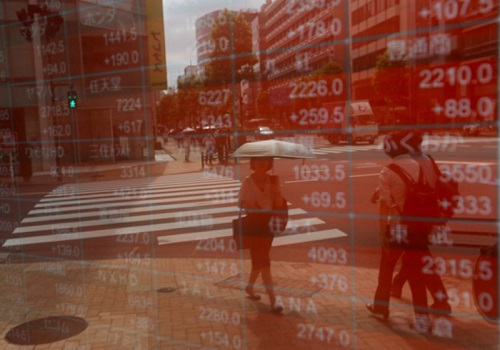Silver trading range for the day is 90665-93225 - Kedia Advisory

Follow us Now on Telegram ! Get daily 10 - 12 important updates on Business, Finance and Investment. Join our Telegram Channel
Gold
Gold prices experienced a modest increase of 0.02% to 74,155, buoyed by the possibility of a U.S. interest rate cut as early as September. Fed Governor Christopher Waller highlighted the central bank's progress towards an interest rate cut, citing improved inflation and a more balanced labor market. Richmond Fed President Thomas Barkin echoed this sentiment, expressing optimism about the broadening of inflation easing. Key U.S. economic indicators showed mixed results: Building Permits rose by 3.4% to 1.446 million in June, and Housing Starts increased by 3.0% to 1.353 million. Additionally, US Industrial Production climbed by 0.6% MoM in June, surpassing the expected 0.3% increase. Conversely, Swiss gold exports in June fell to their lowest level since April 2022, with reduced shipments to China and India due to high gold prices. Despite a nearly 20% rise in spot gold prices this year, physical gold demand in Asia weakened. Indian dealers offered substantial discounts to entice buyers, while Chinese premiums slightly decreased. In Singapore and Hong Kong, gold was sold at modest premiums, and in Japan, it traded at a small discount to a slight premium as investors capitalized on high prices. From a technical perspective, the market saw short covering with a 4.27% drop in open interest, settling at 12,451. Gold prices, up by 18 rupees, find support at 73,960, with potential tests at 73,760 if breached. Resistance is expected at 74,450, and surpassing this level could see prices testing 74,740.
Trading Ideas:
* Gold trading range for the day is 73760-74740.
* Gold steadied helped by prospects for a cut to U.S. interest rates as early as September.
* Fed’s Waller said that the US central bank is ‘getting closer’ to an interest rate cut as inflation's improved trajectory and a labor market in better balance.
* Fed’s Barkin said he is "very encouraged" that easing in inflation has begun to broaden and he would like to see it continue.
Silver
Silver prices declined by 0.18% to 91,772, weighed down by demand uncertainties, while investors awaited updates from the Third Plenum. The anticipation of an interest-rate cut cycle by the U.S. Federal Reserve limited the gains in the dollar and Treasury yields. Recent dovish remarks from Fed officials, coupled with a weaker dollar and subdued Treasury yields, have increased the appeal of precious metals. Signs of a cooling U.S. labor market and further dovish comments from Fed officials could sustain this positive momentum. Fed Governor Christopher Waller and New York Fed President John Williams highlighted the nearing prospect of a looser monetary policy. Richmond Fed President Thomas Barkin expressed optimism about the broadening decline in inflation. The number of people claiming unemployment benefits in the U.S. rose by 10,000 to 243,000 for the week ending July 13th, surpassing market expectations of 230,000. This increase, along with other key indicators, suggests a softening U.S. labor market, reinforcing expectations of a potential rate cut by the Federal Reserve by September. The Philadelphia Fed Manufacturing Index surged to 13.9 in July 2024, the highest level in three months, significantly exceeding the forecast of 2.9. From a technical standpoint, the silver market is undergoing long liquidation, with open interest decreasing by 0.38% to settle at 24,002, and prices dropping by 170 rupees. Silver finds support at 91,220, with a possible test at 90,665 if this level is breached. Resistance is anticipated at 92,500, and a move above this could see prices testing 93,225.
Trading Ideas:
* Silver trading range for the day is 90665-93225.
* Silver dropped weighed down by demand uncertainties in, while investors await updates from the Third Plenum.
* Fed's Barkin says disinflation seems to be broadening
* The number of people claiming unemployment benefits in the US rose by 10,000 to 243,000
Crudeoil
Crude oil prices rose by 0.9% to 6,973, driven by an unexpected drop in U.S. crude inventories, sparking optimism that summer travel demand will boost oil consumption. U.S. crude inventories fell by 4.87 million barrels in the week ending July 12, 2024, marking the third consecutive week of decreases and the longest stretch of stockpile reductions since September. This decline contrasted with market predictions of an increase of 0.8 million barrels. Additionally, crude stocks at the Cushing, Oklahoma, delivery hub decreased by 875 thousand barrels, following a 702 thousand draw in the previous week. In China, refinery output dropped 3.7% in June from a year earlier due to planned maintenance and lower processing margins, causing independent plants to cut output amid lackluster fuel demand. Chinese crude oil imports in June fell by 11% year-over-year, totaling 46.45 million metric tons, or approximately 11.3 million barrels per day, as weak profit margins led independent refiners to curb production. Russian Deputy Prime Minister Alexander Novak indicated that the global oil market will balance in the second half of the year and thereafter, due to the production deal among OPEC+ members. From a technical perspective, the market is experiencing short covering, with a significant drop in open interest by 34.31% to settle at 4,852, and prices rising by 62 rupees. Crude oil is finding support at 6,888, with potential testing at 6,804 if this level is breached. Resistance is likely at 7,031, and a move above this could see prices testing 7,090.
Trading Ideas:
* Crudeoil trading range for the day is 6804-7090.
* Crude oil gains as data showed an unexpected drop in U.S. crude inventories last week.
* There is optimism that summer travel demand will boost oil consumption.
* EIA reported a 4.9-million-barrel decrease in crude stocks last week.
Naturalgas
Natural gas prices surged by 4.28% to 177.8, driven by forecasts predicting a return of hot weather in late July and early August, which is expected to boost demand for gas to power air conditioners. The U.S. Energy Information Administration (EIA) revised peak hourly power demand downward to 738,596 megawatts (MW), a figure that would not surpass the previous all-time high of 742,600 MW set on July 20, 2022. This update also indicates the highest demand since July 27, 2023, when usage peaked at 741,815 MW. In July, gas output in the Lower 48 U.S. states increased to an average of 102.2 billion cubic feet per day (bcfd), up from 100.1 bcfd in June and a 17-month low of 99.4 bcfd in May. The record high for monthly U.S. gas output was 105.5 bcfd in December 2023. Meteorological forecasts suggest that temperatures across the Lower 48 states will stay mostly near normal until July 25, after which they are expected to become hotter than normal through at least August 2. U.S. utilities added 10 billion cubic feet of gas into storage during the week ending July 12, 2024, falling short of market expectations for a 28 billion cubic feet increase. From a technical standpoint, the natural gas market is experiencing short covering, with a significant drop in open interest by 22.63% to settle at 29,613. Prices increased by 7.3 rupees, finding support at 171.9, with potential testing at 166.1 if this level is breached. Resistance is expected at 181.2, and surpassing this level could see prices testing 184.7.
Trading Ideas:
* Naturalgas trading range for the day is 166.1-184.7.
* Natural gas gains boosted by bullish forecasts for hot weather to return.
* US utilities added 10 billion cubic feet of gas into storage.
* Gas output in the Lower 48 U.S. states has risen to an average of 102.2 bcfd so far in July, up from an average of 100.1 bcfd in June.
Copper
Copper prices declined by 1.49% to 827.9, weighed down by ongoing concerns about industrial demand in China, the top consumer of copper. Remarks from President Xi Jinping following the CCP’s Third Plenum did not signal specific stimulus measures to boost domestic consumption, intensifying worries about weak factory demand in China's manufacturing sector. This sentiment was exacerbated by recent data showing that the NBS manufacturing PMI contracted for the second consecutive month in June. Additionally, threats of trade barriers from the US and Europe have contributed to the bearish momentum. China’s economy grew slower than expected in the second quarter, further painting a bleak demand outlook since China accounts for around half of global copper demand annually. Copper inventories have increased across various warehouses, including LME-approved, Comex, and Chinese bonded warehouses, indicating weak demand. Speculative interest in copper has also grown, with fund managers holding a net long position of 43,403 contracts on the CME copper contract as of July 8, marking the first increase since May 20. China's refined copper production in June rose by 3.6% from the prior year to 1.13 million metric tons. The global refined copper market showed a surplus of 13,000 metric tons in April, down from a 123,000 metric tons surplus in March. World refined copper output was 2.29 million metric tons, while consumption was 2.28 million metric tons. From a technical perspective, the copper market is experiencing fresh selling, with a 1.68% increase in open interest to settle at 9,441 while prices fell by 12.5 rupees. Copper finds support at 822.2, with potential testing at 816.4 if this level is breached. Resistance is likely at 838.8, and a move above this could see prices testing 849.6.
Trading Ideas:
* Copper trading range for the day is 816.4-849.6.
* Copper fell as pessimism over industrial demand in top consumer China continued to weigh.
* Copper inventories in warehouses monitored by the LME, Comex and SHFE have been increasing so far in July.
* China's refined copper production in June rose 3.6% from the prior year to 1.13 million metric tons.
Zinc
Zinc prices declined by 0.39% to 266, influenced by disappointing economic data from China. China's refined zinc output in May 2024 reached 536,200 metric tons, up 6.26% month-on-month. Additionally, zinc inventory in the Shanghai Bonded Zone increased by 1,500 metric tons to 15,000 metric tons week-on-week. Despite the closed zinc ingot import window, overseas zinc ingots accumulated in the bonded zone, awaiting favorable import conditions. In Australia, MMG Ltd halted operations at its Dugald River zinc mine's mill for approximately two months for repairs. This closure is expected to exacerbate the already tight zinc concentrates market, although MMG stated the mill stoppage would have minimal impact on overall 2024 production. Investors are closely monitoring the potential impact of anticipated stimulus measures from Beijing, especially those aimed at supporting China's debt-ridden property market. Zinc inventories in warehouses registered with the London Metal Exchange (LME) rose by 9% to their highest level in nearly three months, indicating a surplus of metal in the market. LME zinc stocks peaked at 276,100 tons in late February, the highest since May 2021, but had declined by 13% until recently. The global zinc market surplus decreased to 22,100 metric tons in April from 70,100 tons in March, according to the International Lead and Zinc Study Group. From a technical perspective, the zinc market is experiencing long liquidation, with a 1.3% drop in open interest to settle at 2,051 while prices fell by 1.05 rupees. Zinc finds support at 264.4, with potential testing at 262.7 if this level is breached. Resistance is likely at 268.4, and a move above this could see prices testing 270.7.
Trading Ideas:
* Zinc trading range for the day is 262.7-270.7.
* Zinc prices eased as disappointing economic numbers in China weighed on sentiment.
* China's refined zinc output in May 2024 up 6.26% MoM.
* China's MMG Ltd has halted operations at a mill at its Dugald River zinc mine in Australia for about two months of repair work.
Aluminium
Aluminium prices fell by 0.29% to 221.85, pressured by weak demand prospects in China, highlighted by slow economic growth, weak lending numbers, and rising inventories. China's economy grew at 4.7% in the second quarter, marking its slowest pace since the first quarter of 2023. This growth rate was below the 5.1% consensus forecast and the previous quarter's 5.3% expansion. Additionally, bank lending in China rose below consensus in June, further underscoring weak demand. In response to these economic indicators, China's production of primary aluminium in June increased by 6.2% from the previous year, reaching 3.67 million metric tons, the highest single month of production on record since November 2014. This increase is attributed to higher profits, leading producers to ramp up production. New capacity was added in Inner Mongolia, and Yunnan province resumed most of its production due to sufficient hydropower supply during the summer rainy season. The surge in aluminium prices, driven by fund investments in the base metals sector, contributed to increased operations. Producers experienced an average profit margin of 3,152 yuan ($434.09) per ton last month, 27.5% higher than the previous year. From a technical perspective, the aluminium market is under fresh selling, with open interest increasing by 2.04% to settle at 3,144 while prices fell by 0.65 rupees. Aluminium finds support at 220.7, with potential testing at 219.6 if this level is breached. Resistance is likely at 223.7, and a move above this level could see prices testing 225.6.
Trading Ideas:
* Aluminium trading range for the day is 219.6-225.6.
* Aluminium eased as weak demand prospects in China were emphasised by slow economic growth
* China June aluminium output climbs on higher profits
* China's economy grew 4.7% in the second quarter, its slowest since the first quarter of 2023.
Cottoncandy
Cottoncandy prices fell by 1.47% to 56,790, driven by profit booking after recent gains. A significant decline in the area under cotton cultivation in Punjab, Haryana, and Rajasthan contributed to the earlier price increase. These states reported a total of 10.23 lakh hectares under cotton this year, down from 16 lakh hectares last year. In Punjab, the area reduced to 97,000 hectares, a steep drop from the normal 7.58 lakh hectares seen in the 1980s and 1990s. Similarly, Rajasthan's cotton area decreased from 8.35 lakh hectares to 4.75 lakh hectares, and Haryana's from 5.75 lakh hectares to 4.50 lakh hectares in 2024. The USDA's 2024/25 projections indicate higher beginning and ending stocks, with production, domestic use, and exports unchanged. The season average upland farm price is down by 4 cents to 70 cents per pound, influenced by a decline in new-crop cotton futures. Ending stocks are projected to be 400,000 bales higher at 4.1 million, or 28% of use. Globally, the 2024/25 cotton balance sheet shows increased beginning stocks, production, and consumption, with unchanged world trade, leading to ending stocks 480,000 bales higher at 83.5 million. Production forecasts rose by 90,000 bales due to higher area and yield in Burma. Technically, the market is under long liquidation, evidenced by a 1.96% drop in open interest to settle at 351 while prices fell by 850 rupees. Cottoncandy finds support at 56,300, with potential testing at 55,820 if this level is breached. Resistance is likely at 57,280, and a move above this could see prices testing 57,780.
Trading Ideas:
* Cottoncandy trading range for the day is 55820-57780.
* Cotton dropped on profit booking after prices gained as area under cotton in North India drops
* China's agriculture ministry raised its forecast for cotton imports in the 2023/24 crop year by 200,000 metric tons
* The 2024/25 U.S. cotton projections show higher beginning and ending stocks compared to last month.
* In the global 2024/25 cotton balance sheet, beginning stocks, production and consumption are increased.
Turmeric
Yesterday, turmeric prices rose by 3.04% to settle at 16,218 as farmers are holding back their stocks, anticipating further price increases. However, the upside was limited by news of increased sowing. Turmeric sowing in Erode is reported to be double that of last year, while in Maharashtra, Telangana, and Andhra Pradesh, sowing is estimated to be 30-35% higher compared to last year. Last year, turmeric was sown on approximately 3-3.25 lakh hectares, which is expected to increase to 3.75-4 lakh hectares this year. The previous year's low sowing and unfavorable weather conditions led to an estimated production of 45-50 lakh bags of turmeric in 2024, with an outstanding stock of 35-38 lakh bags. Despite the increase in sowing this season, the upcoming turmeric crop is projected to be around 70-75 lakh bags, with no outstanding stock remaining, suggesting that availability will be lower than consumption in 2025. In 2023, the country produced 80-85 lakh bags of turmeric, with an additional 25-30 lakh bags in outstanding stock. Turmeric exports during April-May 2024 dropped by 20.03% to 31,523.94 tonnes compared to 39,418.73 tonnes in the same period in 2023. In May 2024, around 17,414.84 tonnes were exported, a 23.43% increase from April 2024 but a 12.17% decrease from May 2023. In the Nizamabad market, turmeric prices ended at 16,527.35 rupees, dropping by 0.15%. Technically, the turmeric market is under fresh buying, with open interest increasing by 1.99% to settle at 15,800 contracts while prices rose by 478 rupees. Currently, turmeric has support at 15,830; if it falls below this level, it could test 15,440. Resistance is expected at 16,570, and a move above this could see prices testing 16,920.
Trading Ideas:
* Turmeric trading range for the day is 15440-16920.
* Turmeric gains as farmers are holding back stocks in anticipation of a further rise.
* Turmeric sowing on the Erode line is reported to be double as compared to last year.
* Turmeric was sown in about 3/3.25 lakh hectares in the country last year, which is estimated to increase to 3.75/4 lakh hectares this year.
* In Nizamabad, a major spot market, the price ended at 16527.35 Rupees dropped by -0.15 percent.
Jeera
Yesterday, jeera prices increased by 1.33% to settle at 27,030, driven by robust domestic and export demand amid tight global supplies. However, the potential for higher production is expected to limit the upside. Farmers holding back their stocks in anticipation of better prices also supported the price rise. Jeera production this season is anticipated to be 30% higher, reaching 8.5-9 lakh tonnes, thanks to a substantial rise in the cultivation area. Gujarat's sowing area increased by 104%, and Rajasthan's by 16%.Globally, jeera production has also increased, with China's output rising to over 55-60 thousand tons from the previous 28-30 thousand tons. Similarly, production in Syria, Turkey, and Afghanistan has increased, with new seeds expected in June and July. In India, the sowing area in Mehsana, Banaskantha, and Patan in Gujarat increased by 30-35%, and in Jaisalmer, Barmer, Jodhpur, and Ajmer in Rajasthan by 35%. Gujarat's total jeera production is estimated at a record 4.08 lakh tonnes, compared to 2.15 lakh tonnes in 2022-23. Rajasthan's production also increased by 53%. Despite the production increase, jeera exports during April-May 2024 rose by 43.50% to 58,943.84 tonnes compared to the same period in 2023. However, May 2024 exports dropped by 44.99% compared to April 2024 and by 15.64% compared to May 2023. In the Unjha market, jeera prices ended at 27,401.05 rupees, down by 0.7%. Technically, the market is experiencing fresh buying, with a 2.39% increase in open interest to settle at 27,040 while prices rose by 355 rupees. Jeera currently has support at 26,820, with a potential test of 26,610 if it falls below this level. Resistance is expected at 27,270, and a move above this could see prices testing 27,510.
Trading Ideas:
* Jeera trading range for the day is 26610-27510.
* Jeera gains amid robust domestic and export demand besides tight global supplies.
* China's cumin output soared to over 55-60 thousand tons from the previous 28-30 thousand tons.
* Turkey anticipates producing 12-15 thousand tons, while Afghanistan's output could double.
* In Unjha, a major spot market, the price ended at 27401.05 Rupees dropped by -0.7 percent.
Views express by all participants are for information & academic purpose only. Kindly read disclaimer before referring below views.












 320-x-100_uti_gold.jpg" alt="Advertisement">
320-x-100_uti_gold.jpg" alt="Advertisement">










